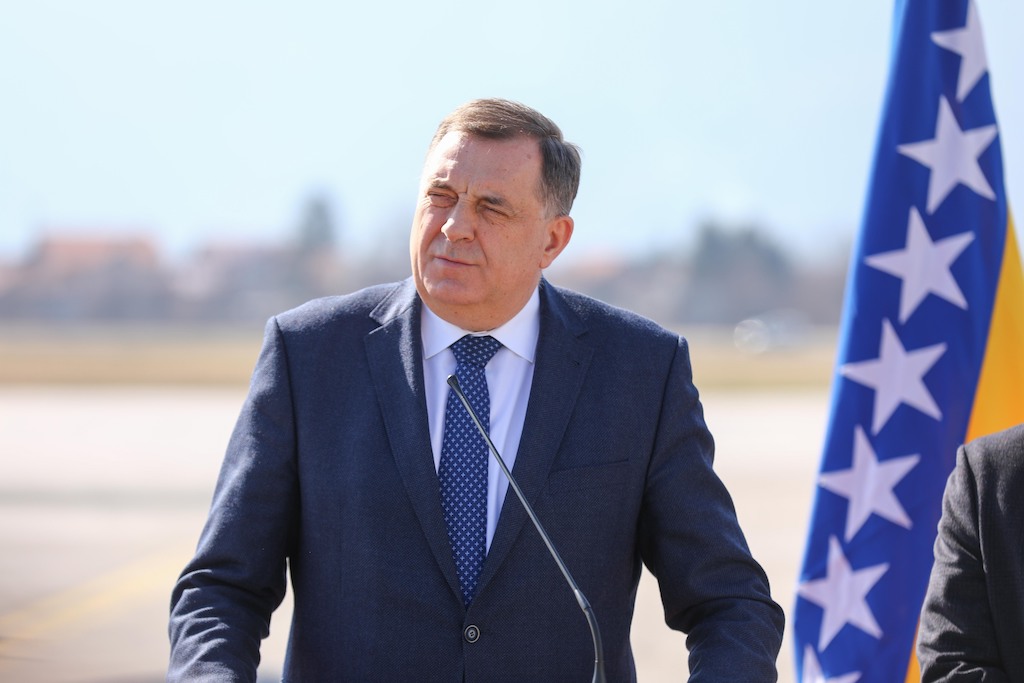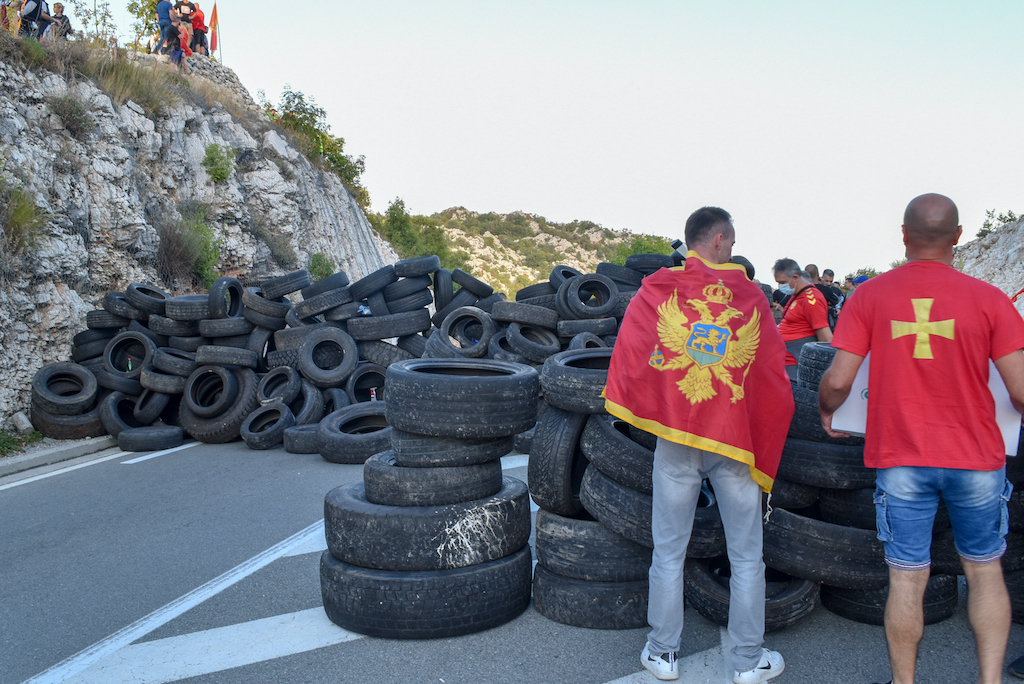Bosnian Serbs stress-test the Dayton Agreement
Republika Srpska’s bid to leave Bosnia and Herzegovina is thought to be part of a Serbian-Russian strategy to destabilize the Balkans and, by extension, the EU.

In a nutshell
- Moscow is turning up the heat to destabilize the Balkans
- Bosnian Serbs and Russia are challenging the Dayton Accords
- Washington is responding with renewed diplomatic energy
After a quarter of a century of fragile peace in Bosnia and Herzegovina following the Dayton Accords (also known as the Dayton Agreement), the multiethnic state’s peace compromise is being stress-tested again. How are Serbs threatening to disband the federation?
The leader of Republika Srpska, one of the two parts making the state (the other is the Bosniak-Croat Federation), is threatening to withdraw the predominantly Serb entity. Long pushing for independence, Milorad Dodik talks of a six-month timeline for the exit, and would like to create a separate Bosnian Serb army. Also, he has rejected the authority of the High Representative for Bosnia and Herzegovina Christian Schmidt, who assumed office on August 1, 2021. The Office of the High Representative (OHR) oversees the civilian implementation of the Dayton Agreement and wields significant powers over Bosnian politics since the end of the 1992-1995 Bosnian War. Mr. Dodik’s nationalist, anti-OHR stance is backed by Russia and Serbia.
On December 1, 2021, according to the Russian daily Pravda, Russian President Vladimir Putin received Mr. Dodik to discuss ways to protect Serbs in the Republika. And on December 10, the Bosnian Serb assembly approved a set of provisions that eventually would allow the Bosnian entity to withdraw from the federal army and key central institutions including the tax and judiciary systems.
Stoking instability
All this has alerted the West, particularly the United States, because it looks like the Serb leader’s recent provocations may be part of a synchronized Serbian-Russian strategy to destabilize the Balkans and, by extension, the European Union. Earlier manifestations of that intention were seen in Montenegro (the Serbian-made “church diplomacy” crisis) and in Kosovo (when, following an administrative dispute between the two governments the Serbian army was positioned at Kosovo’s northern border).
Facts & figures
Peace that is merely a truce
The General Framework Agreement for Peace in Bosnia and Herzegovina was reached on November 21, 1995, in the U. S., at an Air Force Base near Dayton, Ohio, and formally signed in Paris, on December 14 of the same year. It ended the three-and-a-half-year-long Bosnian War, one of several tragic conflicts that accompanied the breakup of Yugoslavia.
Rather than a peace agreement per se, it was a complex compromise for ending the hostilities between the Bosniaks, Serbs and Croats or, as former UK Ambassador to Belgrade Charles Crawford put it in a recent interview for the Albanian Post, a set of ethno-territorial compromises. In a quarter of a century, no meaningful reconciliation between the former combatants has been achieved. One of the accords’ consequences was the emergence of Republika Srpska, which did not exist before the war. Today, the Serb entity is a state within a state, a spoiler blocking the Euroatlantic path for the Federation of Bosnia and Herzegovina, and destabilizing the country in many ways.
“We are very worried,” U.S. State Department Counselor Derek Chollet admitted to the Associated Press. “There is a lot of attention in Washington about the situation here, a lot of concerns about the trajectory that Bosnia is on and fears, first time in 26 years, (the) Dayton (peace agreement) is at its most perilous moment,” he said.
Richard Holbrooke, the architect of the Dayton Peace Agreement, expected from the onset that maintaining the hard-won truce in Bosnia could prove difficult. And indeed, the U.S. envoy for the Western Balkans Gabriel Escobar is busy these days warning the Serbs that Washington has a low tolerance for undermining peace in Bosnia. President Joe Biden’s administration is signaling its active stance in the region. Testifying before the House Foreign Relations Committee in late October 2021, Mr. Escobar sought to assure the somehow skeptical committee that the U.S. and the EU were working jointly on sanctioning Mr. Dodik for his dangerous antics. (The nationalist leader has been under limited U.S. sanctions since January 2017.) As if in response, EU spokesperson Peter Stano pointed out that a framework for measures against troublemakers like Mr. Dodik has been in place for almost a decade.
Kosovo, North Macedonia and Albania already have expelled some Russian diplomats. The Biden administration threatens to take other steps, based on the president’s executive order, against those who undermine peace in the region. According to Radio Free Europe, such a warning was in the letter that U.S. Secretary of State Antony Blinken sent to the three members of the joint presidency of Bosnia and Herzegovina, which includes Mr. Dodik.
‘Serbian Word’
On September 5, 2021, Montenegro’s historical monastery of Cetinje was the scene of a tumultuous protest. A throng of Montenegrins tried to block road access to the town, the seat of the Serbian Orthodox Church (SPC), to prevent the inauguration of its new head. The SPC is the dominant church in the tiny state, but its opponents accuse it of serving Belgrade’s interests. SPC opponents consider the monastery itself as property of the Montenegrin Orthodox Church (not recognized by the orthodoxy).

Montenegro broke away from Serbia in 2006. About a third of its citizens identify as Serbs, and some resent the separation from the Serbian state. The decision to anoint Bishop Joanikije II as the metropolitan of Montenegro brought ethnic tensions to boiling point. In the end, the bishop had to be helicoptered to the monastery’s lawn as the police were dispersing protesters with tear gas.
Montenegro President Milo Dukanovic, keen to reduce the role of the SPC and build up an independent Montenegrin Orthodox church, sided with the protesters, accusing Serbia of deliberately undermining the country’s unity. In the president’s view, Serbia and Russia are destabilizing Montenegro as part of their “Serbian World” strategy, aimed at unifying all Serbs who live in the region. Zdravko Krivokapic, who leads Montenegro’s new, more Serbia-friendly government, rejected these charges and accused the president of deliberately stirring ethnic and religious tensions for political gain.
The stance of Belgrade is that Bosnia-Herzegovina, Montenegro, Kosovo and North Macedonia are temporary states.
The prospect of destabilizing Montenegro, a NATO member, prompted U.S. envoy Escobar to visit Sarajevo and Podgorica in quick succession. His message in both capitals was the same: the U.S. will not allow destabilization, whether in the country or in the region. According to the U.S. Embassy in Podgorica, Mr. Escobar restated Washington’s firm support for Montenegro’s sovereignty and its efforts to advance the reforms needed to join the EU. Also, the Democratic Front of pro-Serbian parties in Montenegro was not a partner of the U.S.
In October, it was Kosovo’s turn to be targeted by Serbia. That time, MiG jets of the Serbian Air Force flew over the northern part of Kosovo’s territory, and Serbian T-72 battle tanks gathered right across its border with Serbia. The buildup, monitored by the Serbian defense minister and Russia’s ambassador in Belgrade, was triggered by the two countries’ ongoing dispute over automobile license plates. The tense standoff lasted 12 days, alarming international leaders and causing the NATO-led KFOR peacekeeping force to intensify its patrolling. Kosovo’s Prime Minister Albin Kurti told The Guardian newspaper that “Serbia does not recognize its neighbors who are not part of EU. … The stance of Belgrade is that Bosnia-Herzegovina, Montenegro, Kosovo and North Macedonia are temporary states that Serbia has either to control or to undo.”
Move against peacekeeping
In November, the internal conflict in Bosnia and Herzegovina found its way to the United Nations Security Council: Russia and China acted as international advocates of Republika Srpska. The two permanent members of the council launched a resolution to shut down the Office of the High Representative and terminate the peacekeeping force in Bosnia. Russia has long backed Republika Srpska’s demands to that effect. Again, the measure failed: the Security Council extended the peacekeeping force’s authorization for another year. However, all mentions of the OHR were deleted from the text of the resolution to appease Russia and China. This came after High Representative Schmidt said in his first report to the Security Council that Bosnia and Herzegovina faced an “existential threat” from separatist actions by Bosnia Serbs.
China has joined Russia as a voice for Republika Srpska at the UN. Until now, Beijing had remained silent. It had not been a signatory of the Dayton Accords, and in 2000 it left the Peace Implementation Council, which consists of 55 states and international organizations that contribute money or military troops to the peacekeeping effort in Bosnia.
Russia and China vowed to continue fighting against “Western interference” in the Balkan country.
After the November vote, Russia and China vowed to continue fighting against “Western interference” in the Balkan country, conveniently forgetting that over two decades that “interference” brought Bosnia and Herzegovina some 6 billion euros donated chiefly by the EU, the U.S. and Japan. Since its establishment in 1995, the OHR has issued 140 legally binding orders and caused dismissals of a similar number of officials for violating Bosnia and Herzegovina’s constitution and laws. One of the last decisions of former High Representative Valentin Inzko (2009-2021) criminalized negating the Srebrenica genocide, and several officials, including Mr. Dodik, who had publicly denied that genocide, found themselves under investigation by the Bosnian prosecutor’s office.
Scenarios
The failure of the joint Russia-China assault on the Dayton Accords augurs well for preserving the security system, at least for now. Even if the two powers managed to terminate the OHR, the international civil mission, little would change from the security angle. The EU’s EUFOR (which replaced NATO’s SFOR in 2004) will continue to keep peace in the country and prevent a security vacuum there.
Having seen the fargoing consequences of Moscow’s destabilizing policies in other places – in Ukraine, Georgia, Azerbaijan and, lately, at the Polish-Belarus border – Washington is unlikely to idly watch as Russia plays similar games in the Balkans. If the need arises, the U.S. and NATO will intervene to prevent a repetition of the region’s tragic history. As was shown during the wars in former Yugoslavia, Europe alone would not manage to stabilize the Balkans.
However, the region is shaky. The peace agreements ended the wars but failed to bring stability. After two lost decades, the Western Balkans face the grave risk of continued political pressure and economic stagnation, which may eventually create a geopolitical vacuum that will attract non-Western players.
The implementation of the Dayton Accords is blocked by ethnic rivalries; the Ohrid Framework Agreement in Macedonia has not been fully implemented, and there is no peace treaty yet between Kosovo and Serbia. Montenegro is presently stress-tested by Russia, and North Macedonia remains the longest-waiting EU candidate. The first NATO member in the region, Albania, is also left with unclear accession prospects.
On the positive side, Washington will likely make good on its promise of resuming a robust stand in the region. As in the days of the Holbrooke diplomacy, diplomacy is expected to be backed by force. The Biden administration is reaching out to the proven team from the 1990s: five of its top diplomats were engaged in the region a quarter-century ago. In addition to Mr. Escobar, four other U.S. ambassadors to the Balkans were recently nominated by President Biden.
Jointly, the U.S. and the EU should be able to shore up stability in the Balkans despite Russia’s and China’s more assertive presence.
War remains marginally likely. In the 1990s, none of the states fighting in the Balkan wars were members of NATO; the Western military alliance was only an intervention force. Today, three out six countries – Albania, Montenegro and North Macedonia – are NATO members, and two others – Kosovo and Bosnia and Herzegovina – have NATO troops on their territories. Only one Balkan state, Serbia, is opposed to NATO.








